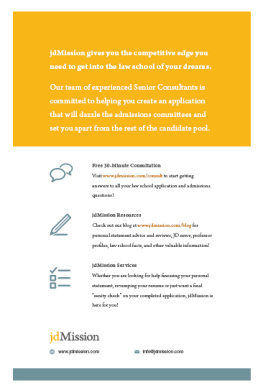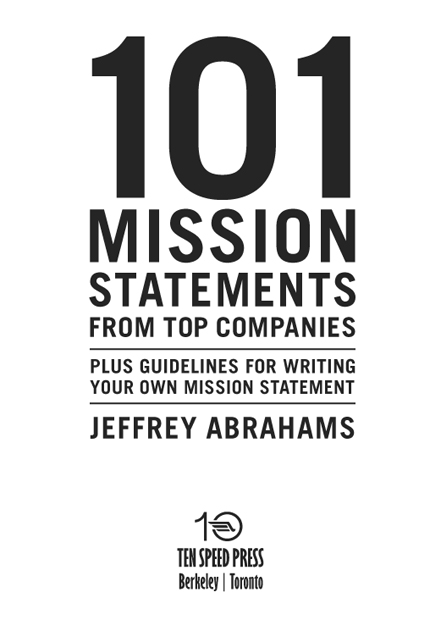Mission statement work is the single most important work because the decisions made there affect all other decisions.
Dr. Stephen Covey
author of The 7 Habits of Highly Successful People
The inclusion of these mission statements is not intended to convey business information to be relied upon in generating business statements or in making business decisions. The publisher does not explicitly or implicitly offer any representation or warranty that these mission statements will be of any use in forming a business conclusion.
Each mission statement is reprinted exactly as it was received from the company of origin.
Copyright 2007 by Jeffrey Abrahams.
All rights reserved. No part of this book may be reproduced in any form, except brief excerpts for review, without the written permission of the publisher.

Ten Speed Press
PO Box 7123
Berkeley CA 94707
www.tenspeed.com
Distributed in Australia by Simon and Schuster Australia, in Canada by Ten Speed Press Canada, in New Zealand by Southern Publishers Group, in South Africa by Real Books, and in the United Kingdom and Europe by Publishers Group UK.
Library of Congress Cataloging-in-Publication Data
Abrahams, Jeffrey.
101 mission statements from top companies / Jeffrey Abrahams.
p. cm.
1. Mission statementsAuthorship. 2. Mission statementsUnited States. I. Title. II. Title: One hundred and one mission statements from top companies.
HD30.285.A267 1999
658.4012dc22
2006037617
eISBN: 978-0-307-81470-8
v3.1
ACKNOWLEDGMENTS
It took more than two years of research and release-form wrangling to complete this book. Thus, I am very grateful to representatives from each of the companies profiled for granting me written permission to reprint the text of their proprietary mission and vision statements.
My personal mission to get this information into your hands, dear reader, would not have been accomplished without the support of the mission-savvy people at Ten Speed Press. To Lorena Jones, publisher, thanks for sticking with this project and believing in the merit of the subject as well as the author. And to my editor Veronica Randall, abundant huzzahs to you for doggedly unsnarling all the knotty issues this project presented to you. Thanks are also due to Laura Milton for a fresh, sleek design. Finally, thanks to Phil Wood for welcoming me into the family of Ten Speed Press authors so long ago and keeping the door open to receive my ideas and proposals for projects.
TABLE OF CONTENTS
PART 01:
HOW TO USE THIS RESOURCE
PART 02:
THE COMPANIES
AND THEIR STATEMENTS
PART 01:
HOW TO USE THIS
RESOURCE
This book has been designed to help you understand the nature, structure, style, and language of a company positioning statement known generally as a mission statement. It is also intended to provide a how-to or rewrite your organizations statement, whether you work for a large corporation, small company, a nonprofit organization, government agency, municipality, or university.
Part 01 offers some guidelines for writing a mission, vision, or other type of company statement. Part 02 is a compendium of 101 mission statements selected from the Fortune 1000 and other sources.
As you know, writing can be hard work. And when something as important and visible as a mission statement is being created, there may be many editors who have a hand at shaping the final words. Therefore, the guidelines I have provided are intended to help facilitate the process, not automatically formulate the results.
COMPANIES ARE LIKE PEOPLE
THEY NEED A MISSION
Whenever and wherever men and women have endeavored to achieve something purposefully, a statement of mission or purpose is pronounced. It precedes the first step in a long march. And it is etched in stone over the entrances of great buildings. People, by their very nature, seem to ennoble a task by endowing it with a stated mission.
Corporations as entities and people as individuals share certain characteristics. Over time, they develop personalities that shape their philosophies and motivate their actions. And without a purpose or a mission, both a person and a company will flounder.
Shaping the identity of a corporation really begins with defining its mission. Its reason for being. Its purpose. Focus. Goal.
Every company, no matter how big or small, needs a mission statement as a source of direction, a kind of compass, that lets its employees, its customers, and even its stockholders know what it stands for and where its headed.
A mission engenders a company with a sense of purposefulness by asserting the reason for its existence.
A mission also serves to unify people in a company, especially when it is comprised of many different kinds of people, in different parts of the country and the world, with varying job titles as well as different levels of training and education. As a unifying touchstone, a mission provides the company and its employees with a sense of identity.
And finally, a mission, simply by its very existence, provides a foundation on which the company can build its future.
A BLUEPRINT
FOR SUCCESS
Theres another way of perceiving what a mission is all about. Consider a mission as part of the set of fundamental principles by which a business operates. The rest of the set could include a vision, goal, slate of operating principles, ethics statement, an environmental policy, and a basic business philosophyamong many other statements.
Thinking of a mission statement as part of a companys overall blueprint for successand communicating that to employees, customers and the publicgives a company a head start on achieving that success.
Please note: I use the term mission statement to include a broad range of approaches and titles used by a wide variety of companies. Some companies put their vision and/or values statements before their mission, if they have one. Simply by shaping a statement, these companies are stating or implying their corporate mission.
TARGET AUDIENCE
THIS MISSIONS FOR YOU
For whom is a mission statement intended? Is it meant for the employees of a company? The members of an organization? The general public? Present or future vendors or clients? In truth, there is no wrong answer to this question. In fact, some companies compose their mission statement in a way that is intended to address all possible audiences. Others purposely create a mission statement that is strictly intended for in-house use only. Still others post their mission in their annual reports, which are made available to prospective investors as well as current shareholders.
In some cases, the target audience is specifically mentioned and therefore clearly identified in the mission statement itself. In instances when more than one audience can be identified, multiple audiences can be addressed within the statement. It is not uncommon for a single mission statement to contain:
To our staff








